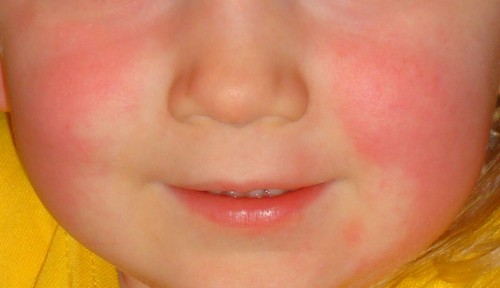Numbered Diseases of Childhood: SECOND Disease – Scarlet Fever
Frankly, the “Numbered Diseases” were just a touch before my time; but, that only means that none of the actual textbooks I used still called them by that name NOT that I haven’t cared for patients with that disease – because I have… lots of ’em!
With the exception of only one disease (FOURTH) they are all still here pestilating earth’s inhabitants, just doing it under the “disguise” of different names. And even FOURTH disease may still be here – we just don’t have proof which one it is.
This is the third in the series covering the Numbered Diseases, a valiant attempt by physicians in 1905 to streamline the medical nomenclature for diseases causing exanthems (rash).
[Photo: Scarlet Fever facial rash with circumoral pallor.]
SECOND Disease – Scarlet Fever
While FIRST disease (Rubeola) was being seen and written about before this time, the 17th century was when the disease which became known as the “scarlet fever” had its appearance in recorded history.
I’m sure the disease itself was around but people who didn’t yet comprehend the nature of contagion just weren’t looking for differentiation from all the other diseases which were causing unfortunates to break out in red blotches with their fever.
And, just like Rubeola, SECOND disease is just as deadly, just as contagious and often leaves its survivors damaged and unhealthy for the rest of their lives. They don’t call it the “Scarlet” fever for nothing!
Contagion and Spread
For those of us who like to split hairs, the bug that causes the disease isn’t the “cause” of the SECOND disease (scarlet fever, scarlatina). Huh?
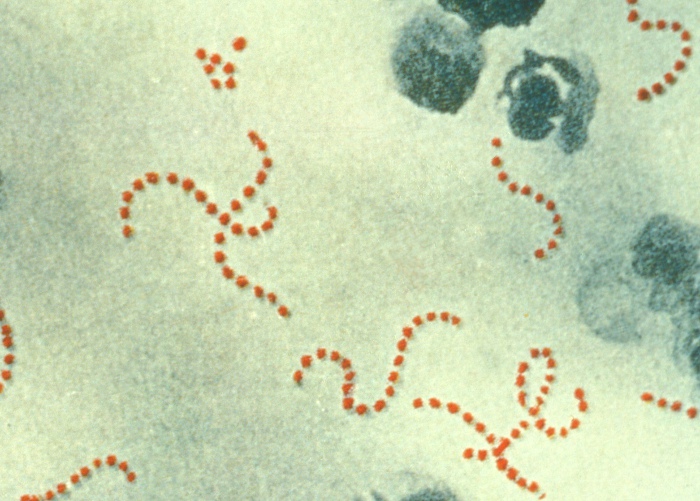 I’m trying not to make this confusing but truly this is a disease that is easiest to diagnose after it’s either completely gone (and you know the complete course after it’s too late to do anything about it) OR by fancy laboratory tests so you don’t get confused by variable physical findings and symptoms.
I’m trying not to make this confusing but truly this is a disease that is easiest to diagnose after it’s either completely gone (and you know the complete course after it’s too late to do anything about it) OR by fancy laboratory tests so you don’t get confused by variable physical findings and symptoms.
You see, the bacteria which starts the whole thing off is streptococcus which is a round, gram positive bacteria found in chains and it also causes several different kinds of illness in addition to Scarlet Fever, including the common sore throat, pink eye and impetigo.
However, the “bug” can itself get infected with what is known as a “bacteriophage” – “phage” for short. When it does, then in addition to its ‘normal’ disease it also starts producing a TOXIN which: adds to its virulence, causes rashes and otherwise raises mayhem in the human body.
Such is the bacteria we know as: “Group A beta-hemeolytic streptococcus.”
Being a bacteria, scarlet fever is transmitted around the family and community on particles of fluid from the mouth, nose or any other place it’s currently causing an infection (see below). Airborne droplets from a cough or sneeze can be inhaled or land on any other surface such as clothing, hands, drinking glasses and utensils, work surfaces, door knobs or just about any other surface.
Then all an unsuspecting victim needs to do is to touch said contaminated surface and touch his own nose, mouth or eyes. If you share towels, baths, clothes or bed linens you risk becoming infected, or even touch the skin of someone with a “strep” skin infection. There are even reports of infections from touching or consuming contaminated foods.
An untreated (heaven forbid) individual will be contagious for several weeks – even after symptoms have gone! And, just to make things more confusing, some people who are not susceptible to the toxins don’t seem to develop symptoms at all – so can become carriers … and contagious. This can occur in up to 15–20% of school-age children.
[Photo: Microscope slide stained to reveal the bacteria streptococcus pyogenes.]
Symptoms and Physical Findings
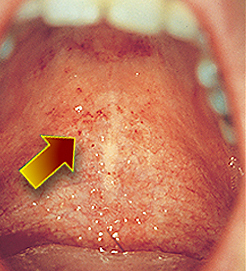 Even though streptococcus can cause several other diseases like sore throat, impetigo, conjunctivitis, bladder infections and the like, SECOND disease most commonly affects children with its peak about 4-10 years of age.
Even though streptococcus can cause several other diseases like sore throat, impetigo, conjunctivitis, bladder infections and the like, SECOND disease most commonly affects children with its peak about 4-10 years of age.
After being infected, the disease incubates in the child for up to four days before giving them a fever (low or high), sore throat (or not), swollen neck glands (usually) and a feeling of “illness.”
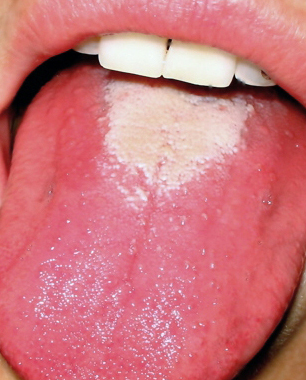 Tiny red “Forchheimer” dots may appear on the soft palate for a short time and the throat and tonsils may become either coated in a whitish covering or become red, swollen and coated with specks of pus.
Tiny red “Forchheimer” dots may appear on the soft palate for a short time and the throat and tonsils may become either coated in a whitish covering or become red, swollen and coated with specks of pus.
Early on, the tongue may have a whitish coating with protruding red papilla (white “strawberry tongue) but then slough to a bright red, speckled color – the “strawberry tongue.”
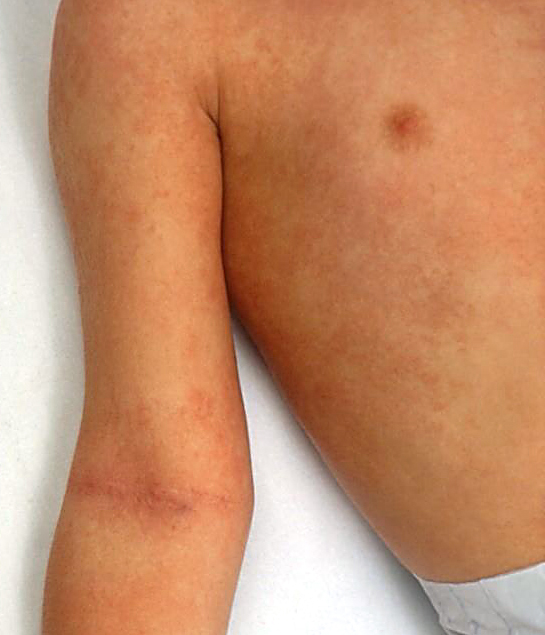 Within one or two days of the fever, the most recognizable part of the disease – the rash – appears, first on the neck and face then rapidly progresses to the arm pits, groin and rest of the body.
Within one or two days of the fever, the most recognizable part of the disease – the rash – appears, first on the neck and face then rapidly progresses to the arm pits, groin and rest of the body.
It is fine, red and bumpy like sand-paper; and it blanches upon pressure. On the face it’s like a sunburn except usually spares the area around the mouth – circumoral pallor.
The tiny dots tend to coalesce in the skin creases, like elbows, axilla and groin, to form lines known as “Pastia lines.”
In three to four days the rash begins to fade and peel, roughly in the same order that it appeared, often taking a week or much longer to end by peeling on the palms.
In rare cases, scarlet fever may develop from a streptococcal skin infection like impetigo. In these cases, the person may not even get a sore throat but remember it’s the toxin secreted by the phage that produces the rash symptoms of SECOND disease – scarlet fever.
However, just because the fever and rash have run their course don’t for a minute think you’re in the clear; because this is the disease which keeps on giving – especially if it hasn’t been treated with antibiotics.
[Photo: Upper-left, Forscheimer spots; right, strawberry tongue; lower-left, pastia’s lines and rash]
Complications
Ok, we’ve established that the bug streptococcus has a life all on its own outside of Scarlet Fever. That’s why when I list all the complications we see from Scarlet Fever you’ll recognize some of them.
And it works both ways. A person can get Scarlet Fever from having these other diseases first and progress into the rash of SECOND disease; Or, can get these diseases as a complication from having Scarlet Fever. That’s why it was such a scourge before the development of antibiotics (see below).
The greatest correlation between these complications and the “strep” bug is adequate and timely treatment with an antibiotic; and just so you can understand why us medico’s are so compulsive about a “full course of antibiotics” I’ll give you a list.
These diseases are all caused by strep. Those listed in blue are less likely to be associated with Scarlet Fever and those in red are more likely. PANDAS is a newly recognized disease which several are currently trying to categorize.
- Ear infection, including otitis media
- Pneumonia
- Sinusitis
- Throat abscess – a pus-filled sac in the throat
- Necrotizing fasciitis – commonly known as flesh-eating disease
- Toxic shock syndrome
- Infection of the bone and bone marrow (osteomyelitis)
- Meningitis – inflammation of the membranes and fluid that surround the brain and spinal cord.
- Some skin infections
- Endocarditis – infection of the heart’s inner lining
- Rheumatic fever
- Inflammation of the kidney(s) – poststreptococcal glomerulonephritis, resulting from certain byproducts of strep bacteria. In some cases there may be long-term kidney disease.
- Acute kidney (renal) failure
- PANDAS (Pediatric Autoimmune Neuropsychiatric Disorders Associated with Streptococcal infections) – there is some evidence that a strep infection may trigger an autoimmune response that exacerbates symptoms of certain childhood disorders, such as OCD (obsessive-compulsive disorder), Tourette syndrome and ADHD (attention deficit hyperactivity disorder). The increase in symptoms usually lasts for less than a few months.
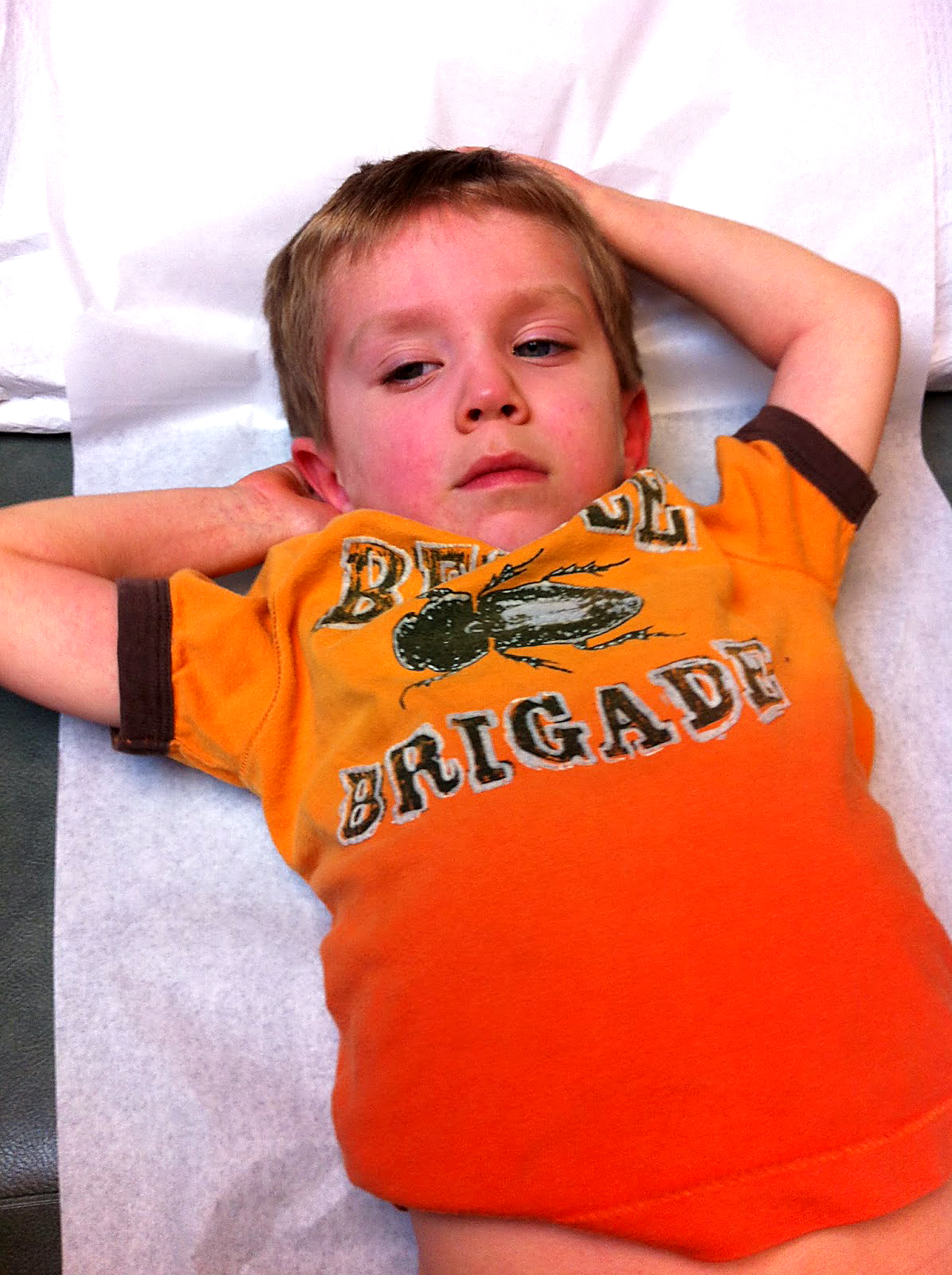
[Photo: right, face and body rash of Scarlet Fever]
Prevention and Eradication
There is no vaccine any more, but the disease is effectively treated with antibiotics. A vaccine was developed before penicillin was produced but abandoned as less effective than the definitive treatment. Now, however, a team in Oklahoma and another in Australia are working on one again.
The best prevention strategies for scarlet fever, as with all highly infectious diseases, are:
- Medication – The only thing keeping the death and complication rate down is the fact that today we have antibiotics effective against strep. They MUST be given early in the course of the disease AND they must be given for a FULL 10 DAY course even though symptoms subside earlier!; Or
- Injection – Alternatively, one injection of the long acting penicillin is good for the entire treatment and should be offered if there is any question that the full ten day course of oral medication will not be complied with.
- Isolation – keep the patient away from other people. Keep the child away from school. A child with the disease is contagious until two to three days after starting antibiotics.
- Dispose or wash – handkerchiefs and tissues that the patient has used immediately. If you have touched any of these wash your hands thoroughly with warm water and soap.
- Handwashing – the patient, usually a child, should be taught to wash his/her hands thoroughly and frequently.
- Dining utensils – do not share drinking glasses or eating utensils with the patient.
- Coughing and sneezing – the patient should be taught to cover his/her mouth and nose when coughing and sneezing. This should be done into a tissue or handkerchief. If one is not available it is better to cough/sneeze into the inside of the elbow – coughing into one’s hands raises the risk of contaminating things when they are touched.
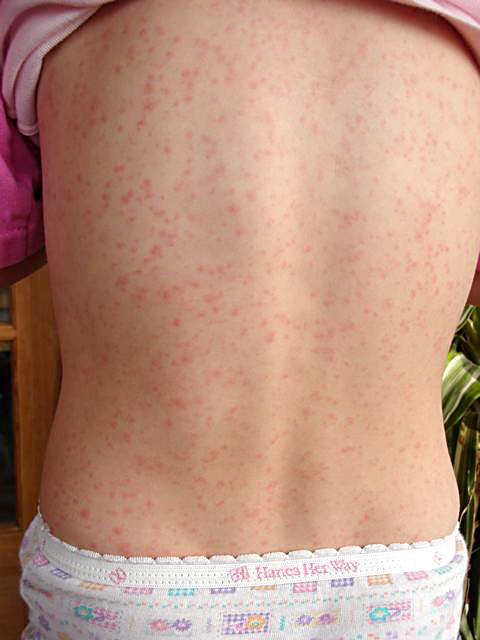
[Photo: Left, Scarlet Fever rash on a child’s back.]
The Rest Of The Story
Before the availability of antibiotics, scarlet fever was a major cause of death. It also caused late complications, such as glomerulonephritis (kidney) and endocarditis (heart) leading to heart valve disease, both of which were protracted and usually fatal afflictions at the time.
Penicillin The Silver Bullet
The fact that there was a “substance” of some kind that would prevent the growth of germs was known long, long, long before medical scientists were able to produce it for use in humans. Alexander Fleming gets the credit and Nobel prize in 1928 but at least six others had been writing about it and even using it on patients for over fifty years!
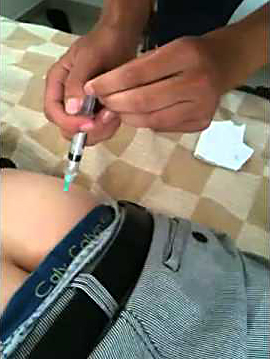 It’s one thing to see that a fungus growing on a petri dish won’t let any streptococcal bacteria grow anywhere close to it – and another thing entirely to be able to “milk” the substance out of the mold; filter, clean and concentrate it; and deliver it into an ill patient!
It’s one thing to see that a fungus growing on a petri dish won’t let any streptococcal bacteria grow anywhere close to it – and another thing entirely to be able to “milk” the substance out of the mold; filter, clean and concentrate it; and deliver it into an ill patient!
And, it didn’t help that some of the discoverers were considered by the establishment “too young” to be believable no matter what they discovered.
People were dying and suffering and the cure was begging to be discovered. Flemming wasn’t paying attention either until the mold took matters into its own… er… pseudopods and jumped onto the petri dish on its own screaming “LOOK WHAT I CAN DO!”
The rest, as they say, is history. A few sporadic patients were helped in England with eye infections and a doctor in Australia was able to use it “inside” a sick patient and almost cured him but he didn’t have enough. He got the Nobel prize anyway in 1945. I hope you’re catching on that this type of stuff is really, really hard! You just don’t wad something up in a ball and call it a pill.
A U.S. drug company trying to coax a vat of mold into giving up its “juice” was able to send 32 liters of it to Boston when they were trying to treat the burn victim survivors of the deadly Cocoanut Grove fire. And it was this humanitarian action that convinced the US Government to incentivize the full scale development of the substance for the use of the troops in the war.
An actual “talent search” of mold was undertaken to find a strain a bit better at its job and a moldy cantaloupe in a Peoria, Illinois market won the prize. The US researcher, Margaret Hutchinson Rousseau, developed the deep-tank fermentation process in 1994 and a large stockpile of penicillin was available for the Allied troops on D-day!
The invention and development of Penicillin actually was the beginning of a complete transformation of medicine in just about every way you can think of. When some bacteria were found not to respond to it, scientists went looking for something that would kill it – and NOW they knew how to go about it!
[Photo: above, right – Penicillin injection to treat strep.]
PANDAS
It’s not until a disease is very well known that doctors begin to notice patients who just don’t seem “do” the disease in the same fashion that others are “doing” it. Sometimes that leads to a different diagnosis and sometimes that leads to such a better understanding that a cure can be found.
 In 2014 we may be on just such a “cusp” of new knowledge by noticing a very small group of children who are responding “differently” to strep infections. These children have been noticed to have dramatic, almost “overnight” onset of symptoms highly unusual for a strep illness – including motor or vocal tics, obsessions, and/or compulsions.
In 2014 we may be on just such a “cusp” of new knowledge by noticing a very small group of children who are responding “differently” to strep infections. These children have been noticed to have dramatic, almost “overnight” onset of symptoms highly unusual for a strep illness – including motor or vocal tics, obsessions, and/or compulsions.
They may become moody and irritable or show concerns about separating from parents or loved ones. Yes, as you can tell, behavior symptoms like these are not only very hard to prove causality but are enough out of the “normal” that there are numerous skeptics; but, this abrupt onset has been seen many times and generally is preceded by a Strep throat infection.
The mechanism? No one really has a clue; but, researchers at the National Institute of Mental Health (NIMH) are pursuing a theory that the mechanism is similar to that of Rheumatic Fever, an autoimmune disorder triggered by strep throat infections.
In every bacterial infection, the body produces antibodies against the invading bacteria, and the antibodies help eliminate the bacteria from the body. However in Rheumatic Fever, the antibodies mistakenly recognize and “attack” the heart valves, joints, and/or certain parts of the brain.
You see, the protein molecules of the strep bacteria “look” so similar in some way to those in the heart valve, joints, or brain that the body’s defense compounds can’t tell the difference. The immune reaction designed to kill the strep also attacks the child with Rheumatic Fever leading to heart disease (especially mitral valve regurgitation), arthritis, and/or abnormal movements known as Sydenham’s Chorea or St. Vitus Dance.
In PANDAS, it is believed that something very similar to Sydenham’s Chorea occurs. One part of the brain that is affected in PANDAS is the Basal Ganglia, which is believed to be responsible for movement and behavior. Thus, the antibodies interact with the brain to cause tics and/or OCD, instead of Sydenham Chorea.
I hope you now can understand why pediatricians are almost obnoxious trying to get you TO FINISH ALL YOUR MEDICINE!
[Photo: Above, left – facial tic following strep infection.]
8 Posts in Numbered Diseases (numbereddiseases) Series
- Part 7 - Roseola - Sixth Disease – 27 Apr 2014
- Part 6 - Erythema Infectiosum - Fifth Disease – 15 Apr 2014
- Part 5 - Filatov-Dukes disease - Fourth Disease – 3 Apr 2014
- Part 4 - Rubella- Third Disease – 26 Mar 2014
- Part 3 - Scarlet fever - Second Disease – 18 Mar 2014
- Part 2 - Measles - First Disease – 10 Mar 2014
- Part 1 - Numbered diseases of childhood – 2 Mar 2014
- Childhood Rashes and Numbered Diseases: Intro/Index – 1 Mar 2014
Advertisement by Google
(sorry, only few pages have ads)

